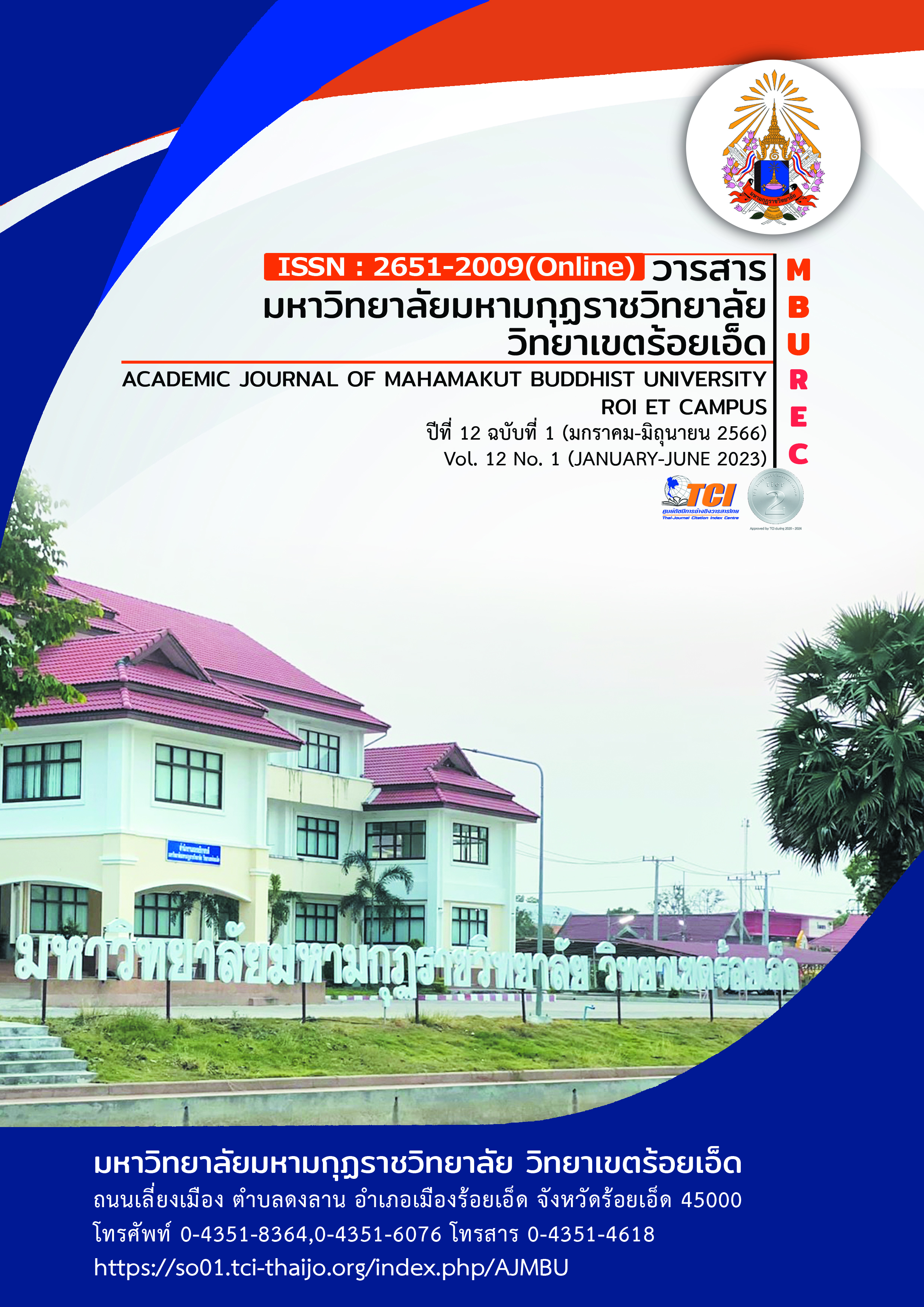THE DEVELOPMENT OF READING COMPREHENSION ABILITY FOR GRADE 7 STUDENTS BY USING THINK-PAIR-SHARE TECHNIQUES AND QUESTIONS
Main Article Content
Abstract
The purposes of this research were 1) to compare the reading comprehension abilities of grade 7 students before and after the learning management by using the think-pair-share technique together with questionnaires and 2) to study the opinions of grade 7 towards learning management with think-pair-share techniques combined with the use of questions. The sample consisted of 34 students in grade 7/1 Thanyarat School, Thanyaburi District, Pathum Thani Province, for the second semester of the academic year 2021. The total number of 34 students was obtained by Simple Random Sampling by using the classroom drawing method random unit. The research instruments were 1) a reading comprehension plan that used a collaborative learning, think–pair–share techniques and question. 2) Aptitude Test in terms of reading comprehension 3) a questionnaire on the students' opinions on learning management by using think–pair–share techniques and question. Statistics for data analysis include mean, standard deviation and dependent samples t-test.
The results of the study were follows:1. The reading comprehension abilities of grade 7 students in the learning management with think-pair-share technique combined with questioning after school is higher than before leaning at. 0.05. 2. The students' overall opinions towards the think-pair-share techniques and using questions were at a high agreement level.
Article Details

This work is licensed under a Creative Commons Attribution-NonCommercial-NoDerivatives 4.0 International License.
References
กรมวิชาการ. (2544). หลักสูตรการศึกษาขั้นพื้นฐาน พุทธศักราช 2544. กรุงเทพมหานคร : พัฒนาคุณภาพวิชาการ (พว).
กระทรวงศึกษาธิการ. (2551). หลักสูตรแกนกลางการศึกษาขั้นพื้นฐานพุทธศักราช 2551. กรุงเทพมหานคร : โรงพิมพ์ชุมชนสหกรณ์การเกษตรแห่งประเทศไทยจำกัด.
ชัยวัฒน์ สุทธิรัตน์. (2559). เทคนิคการใช้คำถามพัฒนาการคิด. พิมพ์ครั้งที่ 5. กรุงเทพมหานคร : วีพรินท์.
นิรันดร์ ตั้งเมธีกุล. (2546). การสอนแบบ KWLH ด้วยการเรียนผ่านสื่ออิเล็กทรอนิกส์ เพื่อส่งเสริม ความเข้าใจในการอ่านภาษาอังกฤษ พฤติกรรมด้านสัมพันธภาพระหว่างบุคคล และด้านกระบวนการสืบเสาะหาความรู้ของนักศึกษาระดับปริญญาตรี. วิทยานิพนธ์ปริญญาศึกษาศาสตรมหาบัณฑิต. บัณฑิตวิทยาลัย : มหาวิทยาลัยเชียงใหม่.
ประทีป วาทิกทินกร. (2553). ลักษณะการใช้ภาษาไทย. กรุงเทพมหานคร : มหาวิทยาลัยรามคําแหง.
ภพ เลาหไพบูลย์. (2537). แนวการสอนวิทยาศาสตร์. กรุงเทพมหานคร : ไทยวัฒนาพานิช.
มนตรี เกื้อทาน. (2561). การศึกษาผลสัมฤทธิ์การอ่านจับใจความของนักเรียนชั้นมัธยมศึกษาปีที่ 2
ที่จัดการเรียนรู้ด้วยเทคนิค KWLH Plus ร่วมกับกิจกรรมการเรียนแบบคู่คิด. วิทยานิพนธ์ปริญญาการศึกษามหาบัณฑิต สาขาการสอนภาษาไทย. บัณฑิตวิทยาลัย : มหาวิทยาลัยศิลปากร.
สุมาลี บุญชู. (2560). ผลการใช้เทคนิคเพื่อนคู่คิดร่วมกับผังกราฟฟิกที่มีต่อความสามารถในการอ่านจับใจความของนักเรียนชั้นประถมศึกษาปีที่ 5. วิทยานิพนธ์ปริญญาศึกษาศาตร มหาบัณฑิต สาขาการประถมศึกษา. ภาควิชาหลักสูตรและการสอน คณะครุศาสตร์ : จุฬาลงกรณ์มหาวิทยาลัย.
สุวิทย์ มูลคํา (2545). 19 วิธีจัดการเรียนรู้เพื่อพัฒนาความรู้และทักษะ. กรุงเทพมหานคร : ภาพพิมพ์.
Slavin, Robert E. (1995). Cooperative learning : Theory, research and practices. 2nd ed. New Jersey Massachusetts : Prentice-Hall.
Slavin, Robert E. (1987). Cooperative Learning and Cooperative School. Educational Leadership. 46. 7-13.


